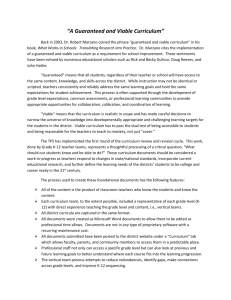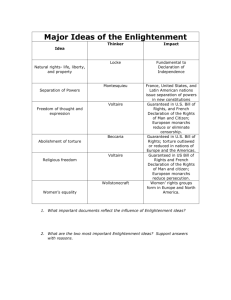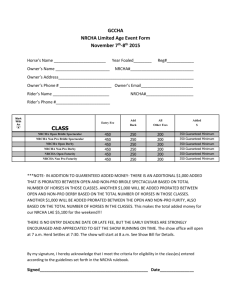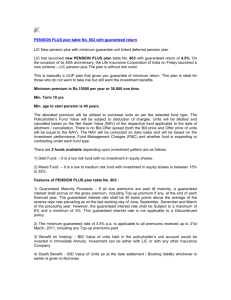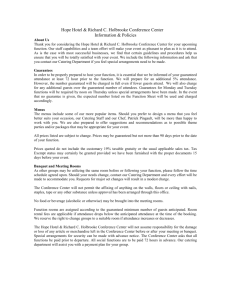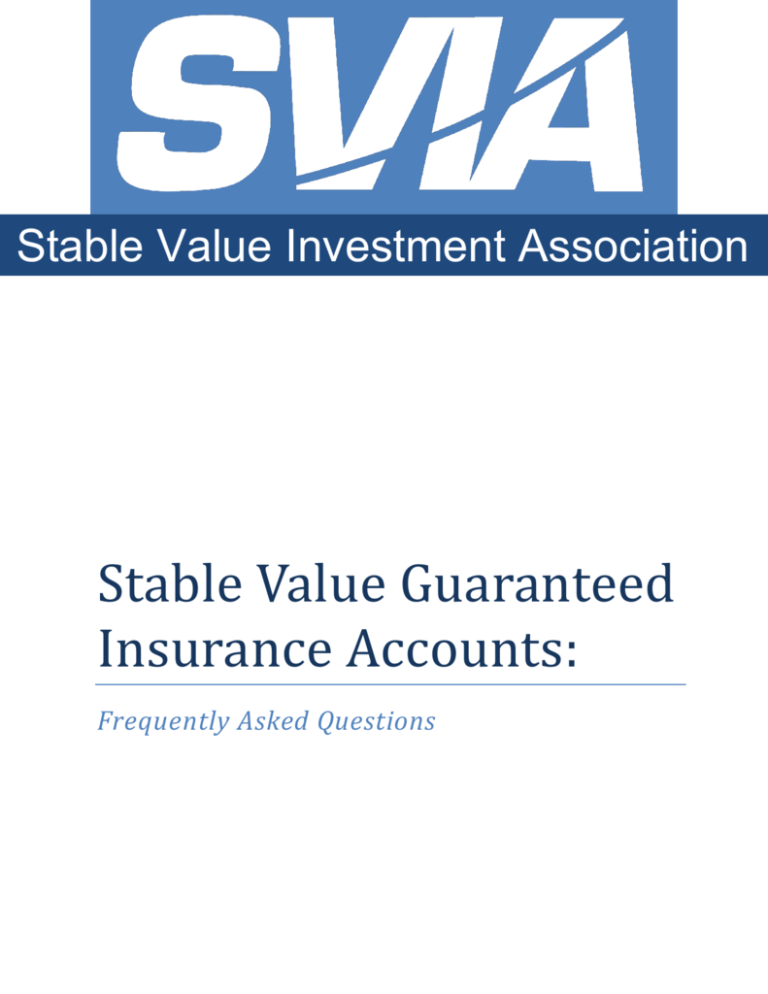
Stable Value Investment Association
Stable Value Guaranteed
Insurance Accounts:
Frequently Asked Questions
This FAQ is limited to an overview of guaranteed insurance accounts and focuses primarily on ‘spread-based’ general
account insurance products. For simplicity, the FAQ assumes a plan uses only one guaranteed insurance account
product for the entirety of its stable value investment option. The FAQ does not address all the variations of
guaranteed insurance accounts or the combination of stable value products that may be used by a plan. This FAQ
does not discuss or compare other stable value products such as synthetic GICs or differences in investment
management. For more information about stable value products other than guaranteed insurance accounts, please
see www.stablevalue.org.
Copyright © 2015 by the Stable Value Investment Association. All rights reserved.
Stable Value Guaranteed
Insurance Accounts:
Frequently Asked Questions
Introduction ………………………………………………………………………………………………………………...…………………………1
What is a stable value guaranteed insurance account?
........................................................................…...2
How do guaranteed insurance accounts serve the needs of defined contribution plans?
……………………..2
What are the strengths of guaranteed insurance accounts? ……………………………………………………………..…….3
What risks does the insurer bear for providing the guarantees? ………………………………………………………..…...4
How does an insurer take on these risks? …………………………………………………………………………………………………4
What are general accounts and separate accounts? ……………………………………………………………………………....5
Why are the disclosure requirements for guaranteed insurance accounts different? ……………………………..5
What is a spread? …………………………………………………………………………………………………….……………………..……….6
Why is it difficult to measure or compare spreads? ………………………………………….………………………..……………6
Why are guaranteed insurance accounts excluded from some DOL fee disclosure requirements? ………...7
What are the plan's exit rights in guaranteed insurance accounts? ………………………………………………………….7
How does a plan get comfortable with a single guarantor behind a guaranteed insurance account?
.…...8
Stable Value - Guaranteed Insurance Accounts
Given the complexity and uncertainty of today’s financial markets and economy, it is no wonder
that plan sponsors and plan participants continue to appreciate the benefits of stable value. As
of December 31, 2014, over 25 million plan participants in more than 165,000 defined
contribution plans invested $705.6 billion in stable value products.1 Throughout their 40-year
history, stable value products have consistently delivered a unique combination of benefits:
liquidity, principal preservation, and consistent, positive returns. Stable value’s unique
characteristics are called “benefit responsiveness.” The standards that determine stable value’s
benefit responsiveness are set by the Financial Accounting Standards Board as well as the
Governmental Accounting Standards Board.
Stable value products, regardless of the product or how it is managed, have weathered various
economic cycles and consistently performed in meeting the needs of plan participants and their
beneficiaries. While stable value continues to deliver as promised, the challenges of the financial
crisis and the Great Recession have resulted in subtle changes within the stable value landscape.
Insurance companies have become more prominent, and have over $375 billion outstanding in
guaranteed insurance accounts.
Because of the significant allocation of assets to guaranteed insurance accounts and the scant
amount of publicly available information, the following FAQ seeks to shed some light on this
segment. This FAQ is limited to an overview of guaranteed insurance accounts and focuses
primarily on ‘spread-based’ general account insurance products. For simplicity, the FAQ assumes
a plan uses only one guaranteed insurance account product for the entirety of its stable value
investment option. The FAQ does not address all the variations of guaranteed insurance
accounts or the combination of stable value products that may be used by a plan. This FAQ does
not discuss or compare other stable value products such as synthetic GICs or differences in
investment management.2
$705.6 Billion Invested in Stable Value Products
Product allocation as of December 31, 2014
Guaranteed Insurance
Accounts - General
Accounts
43%
Cash
3%
Guaranteed Insurance
Accounts - Separate
Accounts
16%
Synthetic GICs
38%
Guaranteed Insurance Accounts| 1
What is a stable value guaranteed insurance account?
Guaranteed insurance accounts are stable value products that are offered to defined
contribution plans such as 401(k), 457, 403(b) and some 529 tuition assistance plans on a full
service or investment only basis, generally managed entirely and guaranteed directly by a single
insurance company.3 The guaranteed insurance account generally represents the entire stable
value investment option. Further, a recent SVIA survey found that guaranteed insurance account
general accounts represent forty percent of stable value assets.4
Guaranteed insurance accounts are provided via a group annuity contract or a funding
agreement that can be issued from either the general account or a separate account of the
insurer. The underlying assets are typically managed by the insurance company or an affiliated
manager.
In all cases, guaranteed insurance accounts are backed by the full financial strength and credit of
the issuing insurance company.
[Back to Top]
How do guaranteed insurance accounts serve the needs of defined
contribution plans and their participants?
Guaranteed insurance accounts are similar to other stable value products that are used in
pooled funds or individually managed funds since they all deliver principal preservation, cash like
liquidity for participant driven transactions, and consistent, positive returns that are generally
higher than money market funds. Guaranteed insurance accounts often cater to the needs of
small to medium-sized plans.
Stable value products are tailored to meet the needs of a specific plan participant population
and/or group of plans and their plan participants. While all stable value products deliver the
same basic benefits, there are differences in structure, levels of guarantees, as well as some
contractual features. Having this multitude of structures enables plan fiduciaries to select the
stable value product that is best suited to their specific plan participants’ needs. The chart below
provides an overview of stable value products.
[Back to Top]
Stable Value Product
Description
Guaranteed
Insurance Accounts:
General Accounts5
Contracts and agreements with an insurance company that
provide principal preservation, benefit responsiveness, and a
guaranteed fixed or indexed rate of return backed by the assets
of the insurer’s general account.
Guaranteed
regardless of the
performance of the
underlying assets.
Owned by the insurance
company and held within the
insurer’s general account.
Guaranteed
Insurance Accounts:
Separate Accounts
Contracts and agreements with an insurance company that
provide principal preservation, benefit responsiveness, and a
guaranteed rate of return backed first by assets held in a
segregated account separate from the insurer's general
account and then, to the extent there are any shortfalls, by
assets in the general account.
May be fixed,
indexed, reset
periodically, or based
on the actual
performance of the
segregated assets.
Owned by the insurance
company but set aside in a
separate account for the
exclusive benefit of the
plan(s) in the separate
account.
Contracts and agreements with a bank or insurance company
that provide principal preservation, benefit responsiveness, and
a guaranteed rate of return relative to a portfolio of assets held
in an external trust and backed by assets held in the trust.
Provides a periodic
rate of return based
on the actual
performance of the
underlying assets.
Directly owned by the
participating plan(s).
Synthetic GICs
2 |Frequently Asked Questions
Rate of Return
Assets
What are the strengths of guaranteed insurance accounts?
In addition to providing an attractive solution to plans and participants seeking stability, liquidity,
and yield, guaranteed insurance accounts provide the following benefits:
Guaranteed Minimum Interest Rate - While minimum rates vary by structure and
type of product, all stable value contracts guarantee a minimum rate of at least
zero percent, which ensures principal preservation. Guaranteed insurance
account structures often guarantee the minimum rate at higher than zero
percent, typically varying from one to three percent. At no stage in the life of the
contract can the actual crediting rate fall below the guaranteed minimum rate
which is nondiscretionary and contractually stated.
Crediting Rates - Rates are often fixed and guaranteed in advance for up to one
year (sometimes longer) and must be greater than or equal to the guaranteed
minimum rate. The crediting rate and its terms are defined in the contract.
Policyholder Status - These insurance contracts or policies are backed by the full
faith and credit of the insurance company. Claims under the guaranteed
insurance account are pari-passu with other policyholders and ahead of general
creditors to the insurance company.6
Direct Guarantee - The guaranteed insurance account contract is issued directly to
the plan sponsor or trustee who receives a guarantee of benefit responsiveness
from the insurer.
Option to Annuitize Savings - Guaranteed insurance account contracts in the
retirement plan universe typically offer participants the option upon retirement
of withdrawing money as needed or annuitizing (converting their balances into a
regular income stream for life).
Regulatory Safeguards - State insurance regulators oversee insurer reserves and
investments through regulation and regular audits.
Strong Risk Management - Guaranteed insurance accounts are regulated as
guaranteed products and the insurance industry employs a rigorous risk
controlled approach to issuing and managing them.
Broad Usage and Capacity - Guaranteed insurance account contracts are flexible
and broadly available across multiple plan types offering capacity to the
marketplace.
[Back to Top]
Guaranteed Insurance Accounts| 3
What risks does the insurer bear for providing the guarantees?
By declaring a rate in advance that can never fall below the guaranteed minimum interest rate,
the insurance company assumes certain risks7 such as:
Duration or Interest Rate Risk - Longer duration assets expose the insurance
company to potentially larger price fluctuations as interest rates move.
Investment Risk - Lower than expected returns on investments, risk of default,
credit impairment, underperformance, pre-payments or extension risk.
Liquidity Risk - Certain portfolio allocations may not be readily tradable under
certain market conditions.
Cash Flow Risk - Actual plan and participant cash flows may be significantly
different than what was anticipated when the crediting rate was declared.
Capital Risk - If assumptions used while declaring the rate were incorrect and
actual earnings are insufficient to cover the risks the insurer bears, capital is
reduced.
[Back to Top]
How does an insurer take on these risks?
Transferring risk from policyholders to the insurance company is at the very heart of what
insurance companies do every day. Buying an insurance policy is purchasing a promise from the
insurance company to pay on its guarantees and obligations. The insurer assumes risks in
providing these guarantees for which it needs to be compensated in order to meet its
commitment to policyholders and to maintain adequate capital and a viable business.
In order to provide guarantees insurance companies are required to hold capital and build
reserves for their lines of business. The capital deployed has to earn a minimum required return
that varies by company. Internal management as well as regulatory bodies and rating agencies
rigorously monitor the sources, uses, risk, and return on capital. Profits earned increase capital
levels, help preserve the financial strength of the company, and ensure that the company can
meet contractual obligations, all of which benefits policyholders.
[Back to Top]
4 |Frequently Asked Questions
What are general accounts and separate accounts? How do they
relate to guaranteed insurance accounts?
Guaranteed insurance accounts can be structured in two ways: general accounts or separate
accounts. In the general account structure, the assets are invested in and owned by the
insurance company’s general account. This means that the entire general account of the
insurance company, and effectively, the ultimate claims paying ability of the insurer, supports
the stable value guarantees. The assets in a general account are not attributable to any single
policyholder or liability, and the Employee Retirement Income Security Act (ERISA) excludes the
assets supporting these guaranteed insurance accounts from the definition of plan assets and
treatment as plan assets as long as they are guaranteed benefit policies.8
Separate accounts differ from general accounts in that the assets are segregated from the
general account of the insurer. The guarantees for the specific plan are first backed by the
separate account, and only if the separate account assets are insufficient would the general
account step in to make up any potential shortage.
Apart from the structural differences, both the general account and separate account contracts
are remarkably similar in how each delivers stable value’s benefit responsiveness. Benefit
responsiveness provides stable value’s distinct combination of characteristics: liquidity, principal
preservation, and consistent, positive returns, and the ability of plan participants to transact at
contract value, which is principal plus accumulated interest.
[Back to Top]
Why are the disclosure requirements for guaranteed insurance
accounts different from other 401(k) investments?
Because there are different types of stable value products and differences in how they are
structured, there are also differences in their disclosure requirements. Stable value products that
have wraps such as synthetic GICs and some separate accounts9 are very similar to other feebased 401(k) plan investments in terms of disclosure. They are similar since the rates of return
for these products are tied directly and contractually to the performance of the underlying
portfolio over time. These stable value products have crediting rates that are reset using
contractual formulas to pass through the investment performance of the underlying assets.
Because of this, they are required to provide detailed listings of the underlying portfolio holdings
to plan sponsors as well as meet the Department of Labor’s (DOL) fee disclosure requirements.
While there are variations, guaranteed insurance accounts differ because they declare and
guarantee a rate for up to a year or longer in advance. and also provide a minimum guaranteed
rate of return regardless of the performance of the assets. In the case of general account
guaranteed insurance accounts, the rate is not tied directly to the investment performance of a
specific underlying portfolio, but is instead based on the entire general account of the insurer.
Because assets in the general account support guarantees made to all policyholders under
multiple lines of business, they are not attributable to or dedicated to any specific contract. For
interested parties, general account investment holdings are available through annual filings with
state insurance departments.
[Back to Top]
Guaranteed Insurance Accounts| 5
What is a spread?
A spread is the difference between the actual earnings on investments and the crediting rate
that is declared and guaranteed by the insurance company for a given period, which is subject to
the minimum rate guarantee. An insurer attempts to earn a spread using assumptions based on
many factors such as the magnitude and timing of deposits, participant cash flows, investment
performance, rate environment, and potential credit impairments. Spread is used to compensate
the insurer for risk, capital charges, and other expenses.
Spread does not equal profit. There is no certainty an insurance company will earn a targeted
spread or any spread at all. However, the stated rate of return to plan participants is guaranteed.
Investment yields need to be greater than the rate credited to cover an insurer’s expenses, and
that is not always the case. If the investments underperform or if any of the assumptions are
inaccurate, the insurer is still held to the declared crediting rate and the guaranteed minimum
rate.
Other products such as individual fixed annuities and certificate of deposits also earn a spread
income that is expected to be higher than the guaranteed rate.
[Back to Top]
Why is it difficult to measure or compare spreads?
Spread earnings are prospective, variable, and unpredictable. Unlike the fees associated with
products such as variable annuities or mutual funds, which do not offer a guaranteed rate or
assume the risks previously outlined, guaranteed insurance account spreads are not fixed or
scalable. There can even be situations of negative spread should there be sustained investment
defaults, poor performance, or if cash flows are significantly adverse. In addition, spread also
varies based on the insurer’s specific structure of underlying assets, contract terms, and capital
requirements. For these reasons, measurement and disclosure of guaranteed insurance account
spreads do not provide the ability to perform meaningful product or insurer comparisons. Plan
sponsors and their participants are better served to measure the return of the product's
crediting rate, the product’s historical performance, as well as the insurer’s claims paying ability
to assess the long term value of the guaranteed insurance account.
[Back to Top]
6 |Frequently Asked Questions
Why are guaranteed insurance accounts excluded from some of the
Department of Labor’s fee disclosure requirements?
The DOL excluded fixed return products from some fee disclosure under 408(b)(2) and
subsequently stated that these products must “provide a fixed or stated rate of return to the
participant for a stated duration” which guaranteed insurance accounts do during the rate
guarantee period. The DOL defined fixed return products in the preamble to the fee disclosure
regulations as “certificates of deposit, guaranteed investment contracts, variable annuity fixed
accounts, and other similar interest bearing contracts from banks or insurance companies.”10
In addition to being classified as a fixed return product, the supporting investments for general
account guaranteed insurance contracts are managed collectively in the insurer’s general
account and are not earmarked to a specific liability.11 The spread earned by the insurer is not
fixed, changes continuously, is not known until after the expiration of the rate guarantee period,
and as a result, cannot be easily attributed to specific products for purposes of disclosure. The
general account stands behind all products and liabilities, including life insurance products as
well as annuities. Whereas, with other stable value products, the fee is built into the product and
deducted directly from an earmarked portfolio’s return, allowing it to be reported and compared
across similar products.
[Back to Top]
What are the plan's exit rights in guaranteed insurance accounts?
Contract termination options vary depending on the structure of the product, but are always
disclosed in the underlying insurance contract. Typically, contracts allow the plan to terminate
the contract and receive proceeds at the contract value over a stated period of time, either in
installments or a lump sum payment. During this period, the contract remains fully benefit
responsive to participants and is still subject to the guaranteed minimum rate. Many contracts
also allow for an immediate lump sum payment at a calculated market value based on a stated
formula.
[Back to Top]
Guaranteed Insurance Accounts| 7
How does a plan get comfortable with a single guarantor behind a
guaranteed insurance account?
In addition to the fact that any claims related to guaranteed insurance accounts are pari-passu
with other policyholders and ahead of general creditors, insurance companies are highly
regulated with rigorous risk management, oversight processes, and subject to periodic
examinations by the state insurance departments. Reserves prescribed by insurance laws are
held against the liabilities to protect against losses. Rating agencies, which assess an insurance
company’s financial strength and ability to meet claims, examine the insurer’s guaranteed
insurance accounts along with other products when assigning a financial strength rating.
Insurance firms have long histories in the guarantee business and a strong time tested
commitment to the market. Guaranteed insurance accounts performed well through the credit
crisis by consistently generating positive returns. These accounts are often flagship structures
offered through the insurance company’s retirement and other full service platforms. As a result,
the company has a vested interest to preserve them. Plan fiduciaries perform their due diligence
by learning about the financial health and longevity of the company; both initially and on an
ongoing basis to monitor developments.
Selecting the stable value solution that is best for a plan requires analysis of the different types
of stable value products available. While all stable value products seek to preserve capital and
provide competitive returns, there are differences between the various types offered today.
Considering and understanding these differences is fundamental to the selection, monitoring,
and ongoing due diligence for stable value products.
For guaranteed insurance accounts, analyzing and understanding the financial strength of an
insurer is important, as is evaluating the risks that these products address. Further, the
Department of Labor’s regulation on the selection of annuity providers safe harbor for individual
plans12 as well as Interpretive Bulletin 95-1, although intended for defined benefit plans’
selection of annuity providers, offer frameworks for the analysis, selection, and monitoring of
insurance company general accounts.
[Back to Top]
8 |Frequently Asked Questions
Notes
1
SVIA’s Stable Value Funds’ Investment and Policy Survey covering stable value products as of December 31, 2014.
2
For more information about stable value products other than guaranteed insurance accounts, please see
www.stablevalue.org.
3
4
Insurance companies offer several product variations for stable value. These products include:
-
Non-participating fixed term traditional GICs issued by the general account.
-
Open maturity general or separate account guaranteed products with a fixed rate for a period of time.
-
Contracts with or without minimum floor guarantees that are in excess of zero percent.
-
Fee-based synthetic wrap contracts or wraps that are issued by an insurance company separate account.
These are held as an investment within the stable value fund along with other wraps/GICs procured from
other issuers.
Ibid, endnote 1.
5
Guaranteed Interest Contracts (GICs) have characteristics similar to Guaranteed Interest Account General
Accounts.
6
Separate accounts are backed by the assets in the separate account first and then to the extent there is a
potential shortfall, by the general account.
7
For separate accounts whose crediting rate is determined by the performance of segregated assets, some of the
risks described are borne by the plan, not the insurance company.
8
ERISA Advisory Opinion 05-19A (U.S. Department of Labor, 2005).
9
Ibid, endnote 7.
10
Federal Register, Volume 75, Number 202, “Department of Labor, Employee Benefits Security Administration
29 CFR Part 2550, Fiduciary Requirements for Disclosure in Participant-Directed Individual Account Plans; Final,”
page 64916.
11
For simplicity, the various separate account arrangements are not addressed in this section of the FAQ.
12
Federal Register, Volume 73, Number 195, “Department of Labor, Employee Benefits Security Administration
29 CFR Part 2550, Selection of Annuity Providers--Safe Harbor for Individual Account Plans,” pages 58447-58450.
Guaranteed Insurance Accounts| 9
About the Contributors
Gina Mitchell
Aruna Hobbs
President
Stable Value Investment Association
Managing Director, Head of Stable Value Investments
New York Life Investment Management
Warren Howe
James King
National Sales Director: Stable Value
Metropolitan Life Insurance Company
Managing Director, Stable Value Strategic Relationships
Prudential Financial
Phil Maffei
William McLaren
Senior Director, Stable Value Products
TIAA-CREF
Vice President, Stable Value Business Leader
Lincoln Financial
Stable Value Investment Association
1025 Connecticut Ave NW Suite 1000
Washington, DC 20002
202-580-7620
www.stablevalue.org


